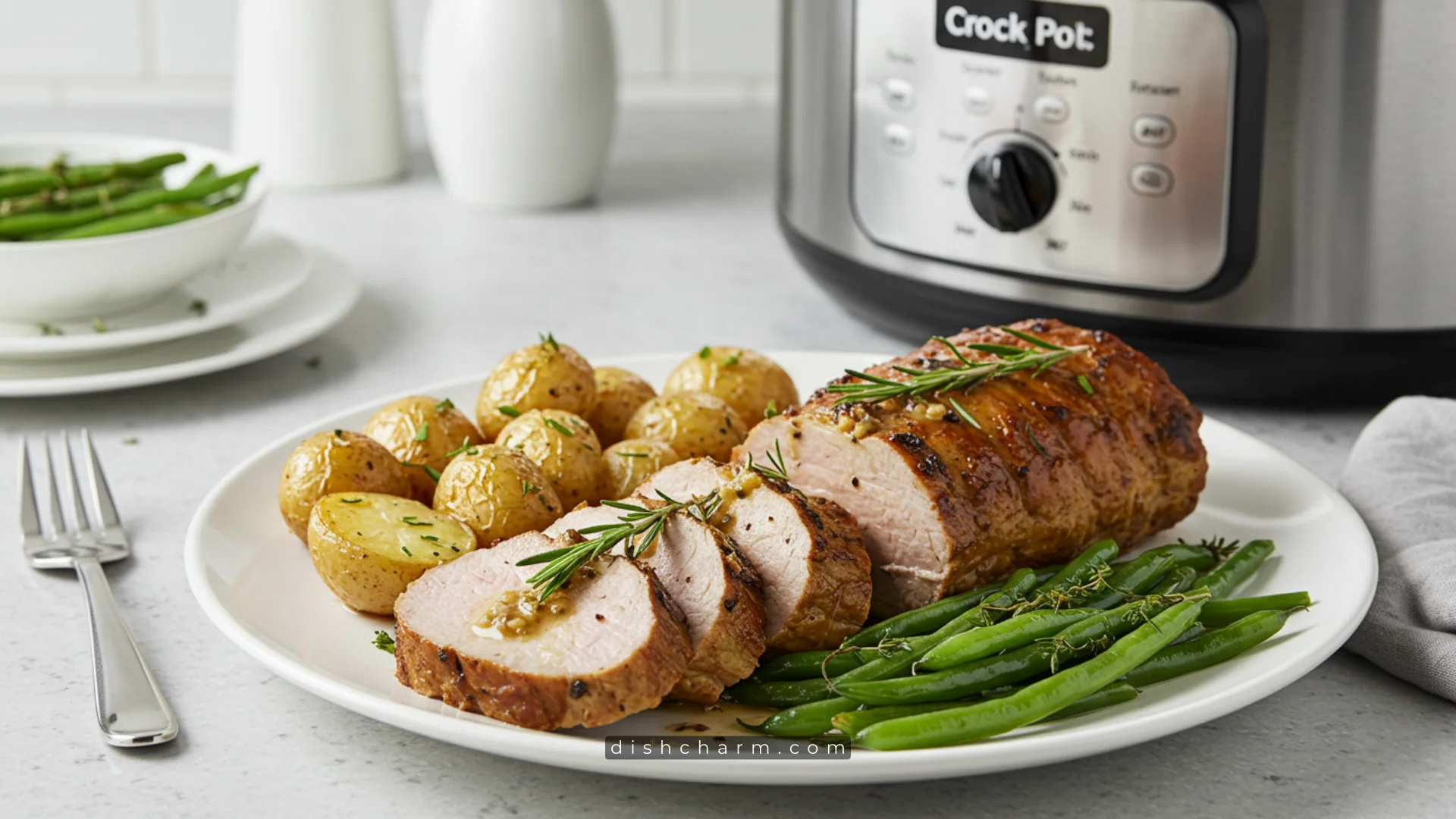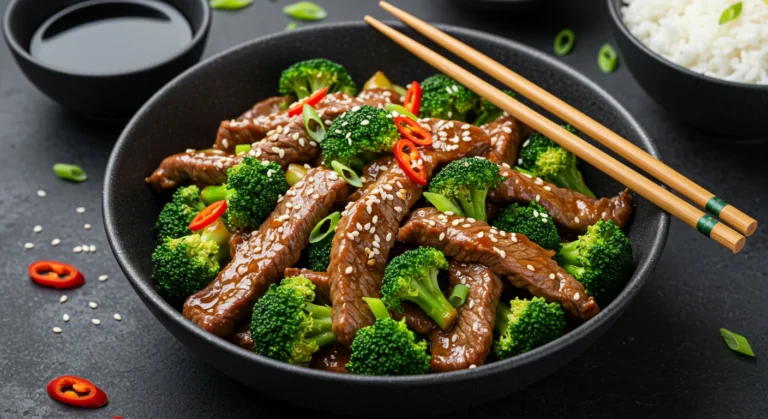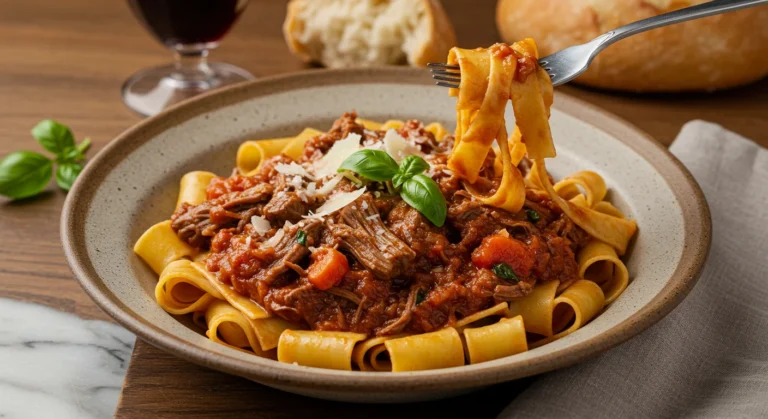Crockpot Pork Tenderloin: Effortlessly Cooked Perfection
Cooking a delicious meal doesn’t have to be a complicated task that takes up your entire day. For those seeking a tasty yet easy option, the Crockpot Pork Tenderloin is a simple solution that allows you to “set it and forget it”. This dish is perfect for busy families wanting to enjoy a homemade meal without spending hours in the kitchen.
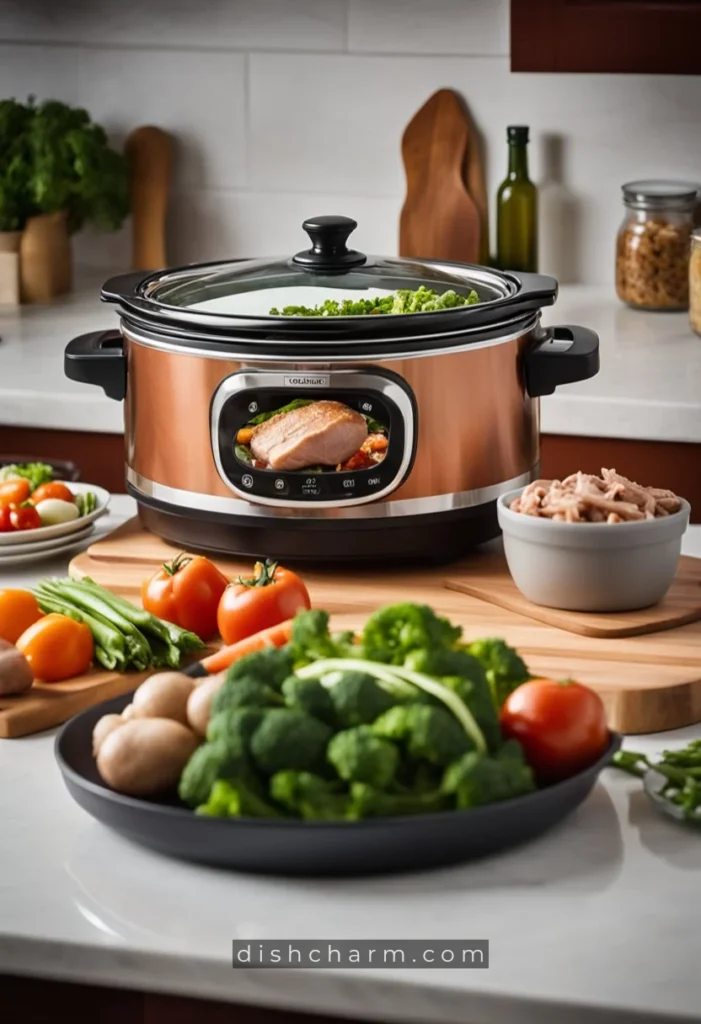
Using a slow cooker, pork tenderloin becomes incredibly tender while absorbing the flavors of the ingredients, ensuring a succulent result every time. It’s a budget-friendly and comforting meal that suits both weekday dinners and special occasions.
Whether serving it with your favorite sides or storing leftovers for another day, crockpot pork tenderloin offers versatility when planning your menu. It brings the comfort of a slow cooker meal with the ease of minimal preparation and maximum taste.
Key Takeaways
- Choose pork tenderloin for a tender, flavorful dish.
- Set the slow cooker and enjoy hands-free cooking.
- Pair with sides or use leftovers creatively.
Choosing the Right Cut
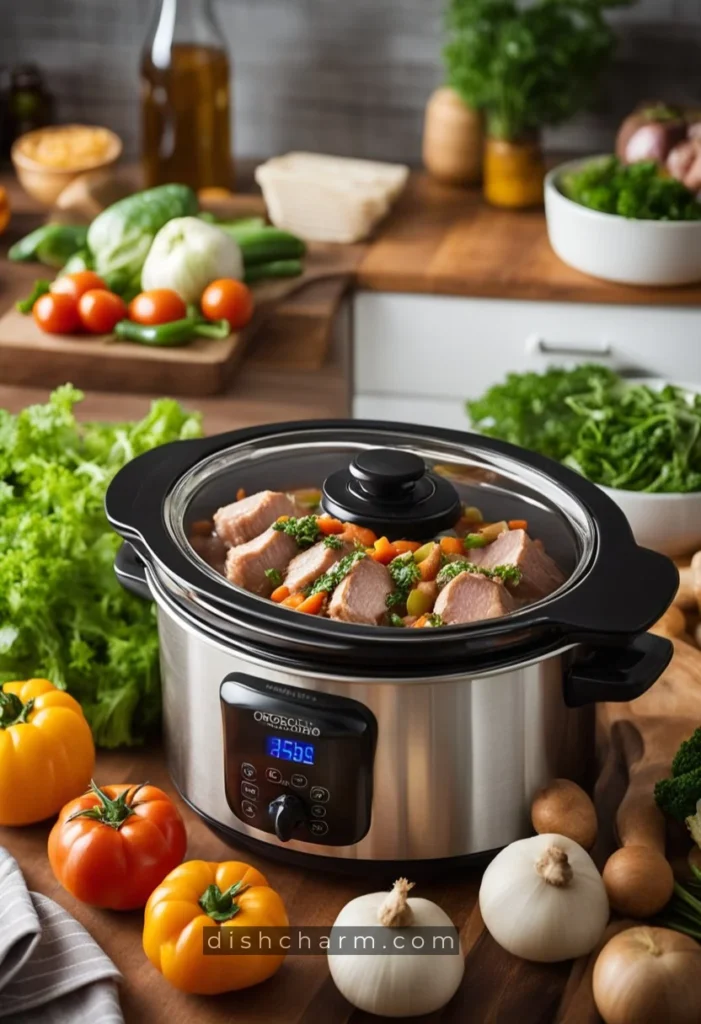
Selecting the right cut of pork is essential for a delicious crockpot tenderloin. Both pork loin and pork tenderloin offer unique benefits, and understanding pork roast helps in making informed decisions.
Pork Loin vs. Pork Tenderloin
Pork Loin is a larger, thicker cut that can handle longer cooking times. It’s great for roasting and works well in recipes needing a crispy outside and moist inside. A crockpot retains its structure, making it suitable for those who prefer slicing over shredding.
Pork Tenderloin is slimmer and more tender. It’s ideal for quick cooking. While it can become dry if overcooked, it benefits significantly from marinades. In a crockpot, it’s essential to monitor the time to ensure it remains juicy. Marinating beforehand can enhance flavors significantly.
Understanding Pork Roast
Pork Roast generally refers to cuts meant for roasting, which include both loin and shoulder cuts. It has more fat compared to the tenderloin. This makes it less ideal for those seeking a leaner option, but excellent for flavor when slow-cooked.
When choosing a pork roast for a crockpot, consider the amount of fat and marbling; this will impact the juiciness and tenderness. Use cuts with sufficient marbling for best results.
A crockpot transforms tougher meats into tender bites by breaking down connective tissues, advantageous for shoulder cuts but less necessary with tenderloin. Picking the right roast depends greatly on desired flavors and textures.
Preparing the Pork Tenderloin
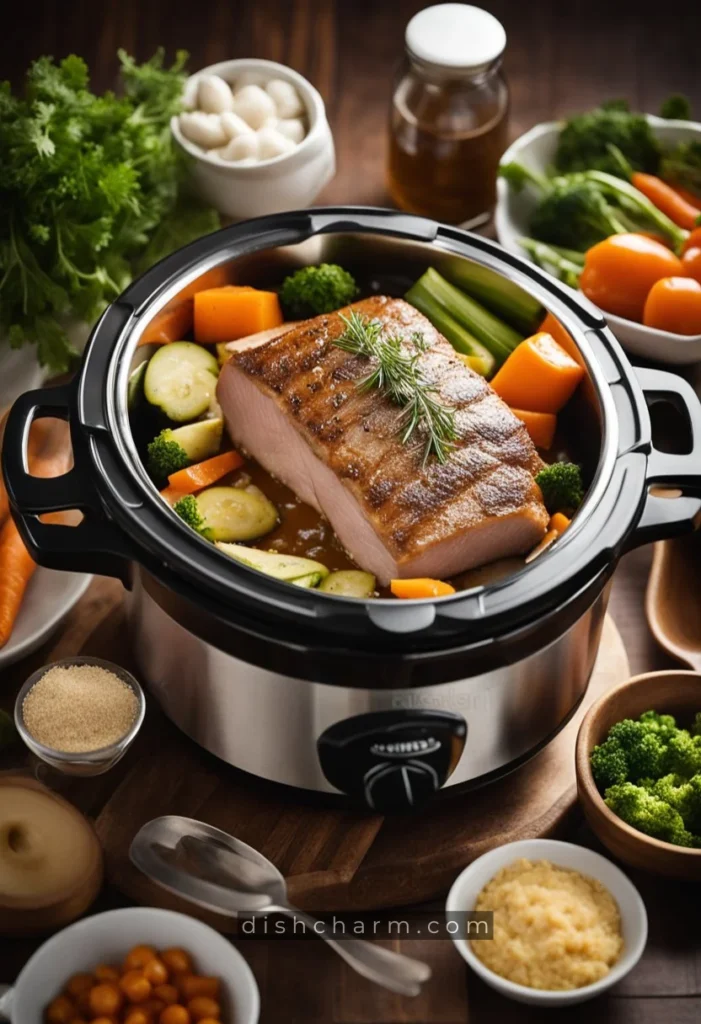
Preparing pork tenderloin for the crockpot involves a few key steps that ensure the meat is juicy and flavorful. These steps include properly trimming and tying the pork, seasoning it well, and marinating it for enhanced taste.
Trimming and Tying
Trimming the pork tenderloin is a crucial first step. Remove any silver skin, which is a tough membrane that can make the meat chewy. Use a sharp knife to carefully cut it away from the meat. This allows the flavors to penetrate better and ensures even cooking.
After trimming, tying the pork helps it cook evenly. Use butcher’s twine to tie the tenderloin every few inches. This keeps its shape and prevents it from falling apart during the slow cooking process. Tying also helps lock in juices, keeping the meat moist and tender.
Seasoning the Meat
Seasoning is essential for bringing out the natural flavors. A simple mix of salt and pepper works wonders and serves as a base layer. For more depth, consider adding garlic powder and freshly minced garlic. These add a savory note that complements the pork.
Thyme is another excellent addition. Its earthy flavor pairs well with pork without overpowering it. A sprinkle of dried thyme adds a subtle aroma that enhances the taste profile. Rub the seasoning mix into the meat, ensuring it covers all sides.
Marinating for Flavor
Marinating the pork tenderloin infuses it with additional flavors. Use a basic marinade of olive oil, minced garlic, and a splash of soy sauce. The olive oil keeps the meat moist while cooking. The soy sauce adds a hint of saltiness that balances the dish.
Let the pork soak in the marinade for at least an hour or up to overnight in the fridge. This resting period allows the flavors to penetrate deeply into the meat. Before placing it in the crockpot, let the tenderloin reach room temperature. This helps with even cooking and enhances the marinade’s impact.
Setting Up the Slow Cooker

Preparing a slow cooker correctly ensures the pork tenderloin cooks evenly and stays juicy. By layering vegetables, adding enough liquid, and choosing the right settings, you can achieve delicious results.
Layering the Vegetables
Begin by placing vegetables at the bottom of the slow cooker. This forms a base that prevents the pork from sticking and adds flavor while cooking. Use vegetables like carrots, onions, or potatoes, which hold up well during slow cooking.
Position the vegetables evenly across the bottom. This helps distribute heat and moisture. Chop the vegetables into uniform pieces to ensure even cooking. The pork tenderloin is placed on top of the vegetables, allowing the flavors to meld perfectly.
Adding Liquids for Moisture
Maintaining moisture during cooking is crucial to a tender pork tenderloin. Adding liquids such as chicken broth or a mixture of broth and water keeps the meat juicy. Ensure there is enough liquid at the base without submerging the pork.
About 1/2 to 1 cup of liquid is typically sufficient. This amount depends on the size of the slow cooker and the quantity of vegetables. The liquid will steam and tenderize the pork, enhancing the dish’s flavors.
Slow Cooker Settings and Timing
Select the appropriate setting and timing for perfectly cooked pork. For tender results, set the slow cooker to low heat. This slow process typically takes about 4-6 hours, perfect for a worry-free cook.
If time is short, use the high setting for 2-3 hours. It’s important to monitor the cooking process with a meat thermometer. Aim for an internal temperature of at least 145°F for safe consumption.
Avoid lifting the lid frequently, as this releases essential heat and moisture. Choosing the right settings and timing is key to a delicious, stress-free meal.
Cooking Process
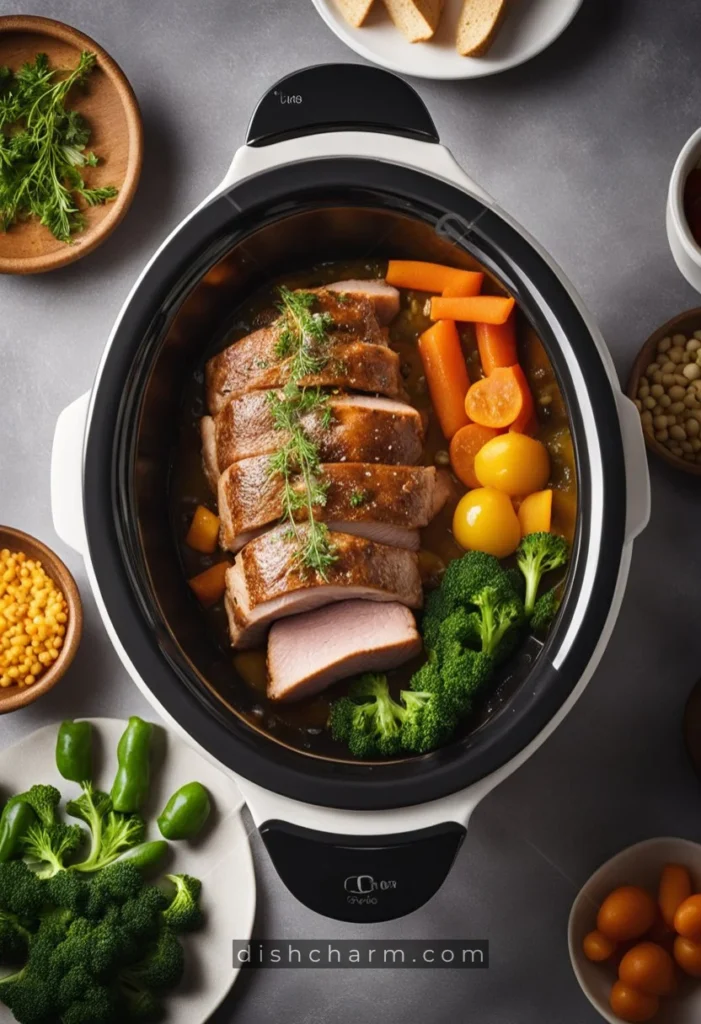
Cooking pork tenderloin in a crockpot ensures a tender and juicy meal. It involves slow-cooking the meat to the right internal temperature and knowing the best time to add final ingredients like honey and soy sauce.
Monitoring Internal Temperature
Using a meat thermometer is essential when cooking pork tenderloin in a slow cooker. The internal temperature should reach at least 145°F to ensure it is safe and fully cooked.
Place the thermometer in the thickest part of the tenderloin. Check the temperature near the end of the cooking time. Slow cookers generally take around 6 to 8 hours on low or 3 to 4 hours on high. Slicing can also help verify doneness if the thermometer is unavailable.
When to Add Final Ingredients
Adding ingredients like honey and soy sauce towards the end maintains their flavors. It is common to incorporate them during the last hour of cooking.
This timing prevents the ingredients from breaking down too much, preserving their taste. Mix these with other flavors like garlic or ginger to enhance the dish. Stirring them in well ensures they evenly coat the tenderloin, offering a rich and appealing glaze.
Serving Suggestions
To enhance your crockpot pork tenderloin meal, consider resting the meat before slicing for added juiciness, slicing the meat to highlight texture and flavor, and pairing it with complementary sides and garnishes. These steps can elevate your dining experience and bring out the best in your dish.
Resting Meat Before Cutting
After removing the pork tenderloin from the crockpot, allow it to rest for about 10 minutes. This helps the juices inside the meat to redistribute evenly, making it tender and moist. Covering the meat loosely with foil can keep it warm and prevent it from drying out.
Using a sharp knife for slicing ensures that the meat doesn’t tear, keeping it presentable. Resting also makes it easier to manage any leftovers, as well-rested meat retains flavor better over time.
Slicing for Presentation
When ready to serve, slice the pork tenderloin into even pieces, about 1/2 inch thick. This size helps keep the slices juicy and manageable to eat. Use a carving knife that’s sharp for clean cuts. Arrange the slices on a platter in a slightly overlapping manner, creating a visually appealing presentation.
Sprinkling a little Parmesan cheese over the slices can add flavor. Adding fresh herbs like parsley or thyme as a garnish gives a splash of color and a hint of extra taste.
Accompaniments and Garnishes
Pork tenderloin pairs well with a variety of sides. Serve it with vegetables such as carrots, potatoes, or green beans to make a balanced meal. Adding a rich gravy enhances the flavor and brings a comforting aspect to the dish.
For a touch of elegance, garnish with fresh herbs like rosemary or sage. Delicate flavors, like a sprinkle of parmesan cheese, can complement the dish without overpowering the main flavor. When stored properly, the leftovers can be used for sandwiches or salads, offering versatility after your meal.
Making the Most of Leftovers
Turning leftover crockpot pork tenderloin into tasty new meals can be both easy and satisfying. It’s important to reheat without drying it out, and also explore creative ways to use the leftovers.
Reheating Without Drying Out
Gentle methods work best to keep leftover pork tenderloin moist. Microwave reheating on low power is effective, especially when combined with a splash of broth or water.
Oven reheating is another option, using a covered dish at low temperatures (around 300°F) to lock in moisture. Wrapping the pork in aluminum foil can help retain its juiciness.
Using a skillet on low heat with some olive oil or butter can also gently warm the slices while adding flavor. It’s important to avoid high heat that could turn the tenderloin dry and chewy.
Creative Leftover Ideas
Leftover pork tenderloin can become a main ingredient in diverse recipes. Shredded pork is perfect for tacos or sandwiches with a bit of Dijon mustard for an extra kick.
Dicing the meat and adding it to a stir-fry with baby carrots and red onion creates a quick, delicious dish.
For a comforting meal, consider pork tenderloin chili. Simply chop the pork and add it to your favorite chili recipe.
For a refreshing twist, consider a pork salad by mixing the tenderloin with greens, nuts, and a light dressing. With a little creativity, leftovers become a delightful experience!
Advanced Tips and Tricks
Mastering a Crockpot pork tenderloin involves techniques like thickening gravy, infusing flavors with herbs, and adjusting for high altitudes. Each of these can elevate the dish to meet personal tastes and environmental needs.
Thickening Gravy
To achieve a luscious gravy, cornstarch is an excellent thickening agent. Mix equal parts cornstarch and cold water to create a smooth slurry. Once the pork is cooked, remove it from the slow cooker. Stir in the slurry gradually over low heat, allowing the sauce to thicken without forming lumps. For added richness, sprinkle in a bit of grated Parmesan cheese. It enhances flavors and contributes to a creamier texture.
Infusing with Herbs
Herbs can transform the taste profile of your pork tenderloin. Fresh herbs like rosemary, thyme, and sage work best. It’s important to add these at the start of cooking for deep flavor infusion. If using dried herbs, remember their flavor is more concentrated, so use them sparingly. A sprig of rosemary or a few sage leaves can add an aromatic twist. This helps in creating a more nuanced and layered taste, making the dish stand out.
Cooking at High Altitudes
Cooking at high altitudes can affect the outcome of your tenderloin. Water boils at lower temperatures here, lengthening cooking times. Increase the cooking duration by about 10-15% while keeping an eye on moisture levels. High altitudes may also require more liquid to avoid drying out the meat. Ensuring the Crockpot lid fits snugly will help maintain necessary steam and liquid during this process.
By considering these advanced tips, anyone can refine their Crockpot pork tenderloin technique, achieving tender, flavorful results consistently.
Health and Safety Considerations
When preparing a crockpot pork tenderloin, it’s crucial to ensure safe cooking practices. Avoiding cross-contamination, proper storage, and confirming the meat is cooked to the right internal temperature are key steps to prevent foodborne illnesses.
Avoiding Cross-Contamination
Cross-contamination can happen when raw pork comes into contact with other foods or kitchen surfaces. To prevent this, it’s important to use separate cutting boards and knives for raw meat and other ingredients. Cleaning and sanitizing counters, utensils, and hands thoroughly after handling raw pork is essential. Use hot, soapy water and consider using a diluted bleach solution for extra sanitation.
Create a prep space specifically for raw pork, and keep other foods at a distance. By following these practices, the risk of spreading harmful bacteria like Salmonella and E. coli can be greatly reduced, making the pork tenderloin dish safe and healthy.
Proper Food Storage
Storing pork tenderloin correctly ensures its safety before cooking. Keep raw pork refrigerated at or below 40°F. Use the pork within a couple of days, or freeze it if not using immediately. When freezing, wrap it tightly in plastic wrap or foil and place it in a freezer-safe bag.
After cooking, store any leftovers in airtight containers. Refrigerate them promptly and consume within 3-4 days. When reheating, ensure that leftovers reach an internal temperature of at least 165°F.
Understanding Doneness
Cooking pork tenderloin to the proper internal temperature is crucial for both safety and taste. The USDA recommends that pork reach an internal temperature of 145°F. Use a meat thermometer to check the temperature, inserting it into the thickest part of the meat.
Allow the pork to rest for at least 3 minutes after cooking. This not only improves juiciness but also ensures that harmful bacteria are destroyed. Utilizing a crockpot can help maintain even cooking, but be sure to monitor cook times and temperature closely to prevent drying out the meat.
Each of these steps is essential to ensure that the pork tenderloin is safe to eat while retaining its desired tenderness and flavor.
Frequently Asked Questions
Understanding how to cook pork tenderloin in a crockpot can greatly enhance the dish’s flavor and texture. Here are answers to common questions that might come up when making this meal.
How long should pork tenderloin be cooked in a slow cooker for optimal tenderness?
Cooking pork tenderloin on low for about 6-8 hours ensures it is tender. This long, slow process allows the flavors to develop fully.
What are the benefits of preparing pork tenderloin in a crockpot versus traditional methods?
Using a crockpot helps the meat become tender and flavorful. It also frees up time, as one can set the ingredients and let them cook without constant monitoring.
Can I add vegetables like potatoes and carrots to my slow cooker when preparing pork tenderloin?
Adding vegetables such as potatoes and carrots can enhance the dish’s flavor and provide a complete meal cooked together in one pot.
What liquid should I use for the best flavor when cooking pork tenderloin in a slow cooker?
Chicken broth, apple juice, or a mix of soy sauce and water can add depth and richness to the pork tenderloin’s flavor.
Are there any tips for achieving a crispy exterior on a pork tenderloin when using a slow cooker?
To achieve a crispy exterior, sear the tenderloin in a pan with oil before placing it in the slow cooker. This can help create a more textured surface.
How can I ensure that my slow cooker pork tenderloin remains moist and doesn’t dry out during cooking?
Keeping the lid closed and using sufficient liquid during cooking will help maintain moisture. Adding a bit of butter or oil can also contribute to keeping the meat juicy.

Crockpot Pork Tenderloin
Equipment
- 1 Crockpot (slow cooker) A medium-sized crockpot works best for this recipe.
- 1 Sharp Knife For trimming and slicing pork.
- 1 Cutting Board For prepping vegetables and meat.
- 1 Measuring Cups/Spoons Ensures accurate portions of seasonings and liquids.
- 1 Butcher’s twine (optional) To tie the pork for even cooking.
Ingredients
- 2 lbs Pork tenderloin Trimmed of excess fat and silver skin.
- 1 cup Chicken broth For moisture and flavor.
- 1 Onion (medium, sliced) medium, sliced Adds sweetness and depth.
- 2 cups Carrots (chopped) Baby carrots work well too.
- 2 cups Potatoes (cubed) Yukon Gold or red potatoes are ideal.
- 2 cloves Garlic (minced) Fresh garlic enhances flavor.
- 1 tsp Salt Adjust to taste.
- 1/2 tsp Black pepper Freshly ground for better flavor.
- 1 tsp Garlic powder (Optional) for extra savory notes.
- 1 tsp Thyme (dried) Earthy aroma complements pork beautifully.
- 2 tbsp Olive oil For marinating or searing (optional).
- 1 tbsp Soy sauce Adds umami and balances flavors.
- (Optional) Parmesan cheese (grated) For garnish.
- (Optional) Fresh parsley or thyme For garnish and added freshness.
Instructions
Prepare Ingredients :
- Trim the pork tenderloin of excess fat and silver skin. Pat dry with paper towels.
- Chop onions, carrots, and potatoes into uniform pieces for even cooking. Mince garlic.
Season the Pork :
- Rub the pork tenderloin with salt, black pepper, garlic powder, and thyme. Ensure all sides are evenly coated.
- Optionally, marinate the pork in olive oil, minced garlic, and soy sauce for 30 minutes to enhance flavor.
Layer Vegetables in Crockpot :
- Place sliced onions, chopped carrots, and cubed potatoes evenly at the bottom of the crockpot.
Add Pork and Liquids :
- Place the seasoned pork tenderloin on top of the vegetables. Pour chicken broth around the edges to prevent drying out.
Cook :
- Cover and cook on low for 6–8 hours or high for 3–4 hours , depending on your schedule.
Rest and Slice :
- Once cooked, remove the pork and let it rest for 10 minutes. Slice into ½-inch thick pieces.
Garnish and Serve :
- Arrange sliced pork on a platter with vegetables. Garnish with grated Parmesan cheese and fresh herbs like parsley or thyme.
Notes
-
- Customization : Add other vegetables like green beans or bell peppers for variety.
- Storage : Store leftovers in an airtight container in the fridge for up to 3 days. Reheat gently to avoid drying out the pork.
- Freezing : Freeze cooked pork and vegetables separately for up to 3 months. Thaw overnight in the fridge before reheating.
Frequently Asked Questions
-
Can I use pork loin instead of pork tenderloin?
- Yes! Pork loin is larger and may require longer cooking time. Adjust accordingly.
-
How can I make this dish gluten-free?
- Use gluten-free chicken broth and ensure soy sauce is tamari-based.
-
What’s the best way to reheat leftovers?
- Reheat in a skillet with a splash of broth or water to retain moisture. Avoid microwaving, as it can dry out the pork.
-
Can I freeze this dish?
- Yes! Freeze cooked pork and vegetables separately for up to 3 months. Thaw overnight in the fridge before reheating.
-
How do I prevent the pork from drying out?
- Avoid overcooking by checking tenderness after 6 hours on low. Resting the meat after cooking also helps retain juices.
Tips & Tricks
- Flavor Enhancement : Tie the pork with butcher’s twine to maintain its shape and lock in juices during cooking.
- Presentation : Garnish with fresh herbs and grated Parmesan for an elegant touch.
- Versatility : Leftovers can be shredded and used in sandwiches, salads, or tacos for quick meals.
Presentation Tips
- Garnish : Sprinkle grated Parmesan cheese and chopped parsley or thyme for color and freshness.
- Serving Style : Serve on a platter with vegetables arranged around the sliced pork for a visually appealing presentation. Pair with crusty bread or a side salad for a complete meal.
- Beverage Pairings : Offer a light white wine like Chardonnay or sparkling water with lemon for non-alcoholic options.

